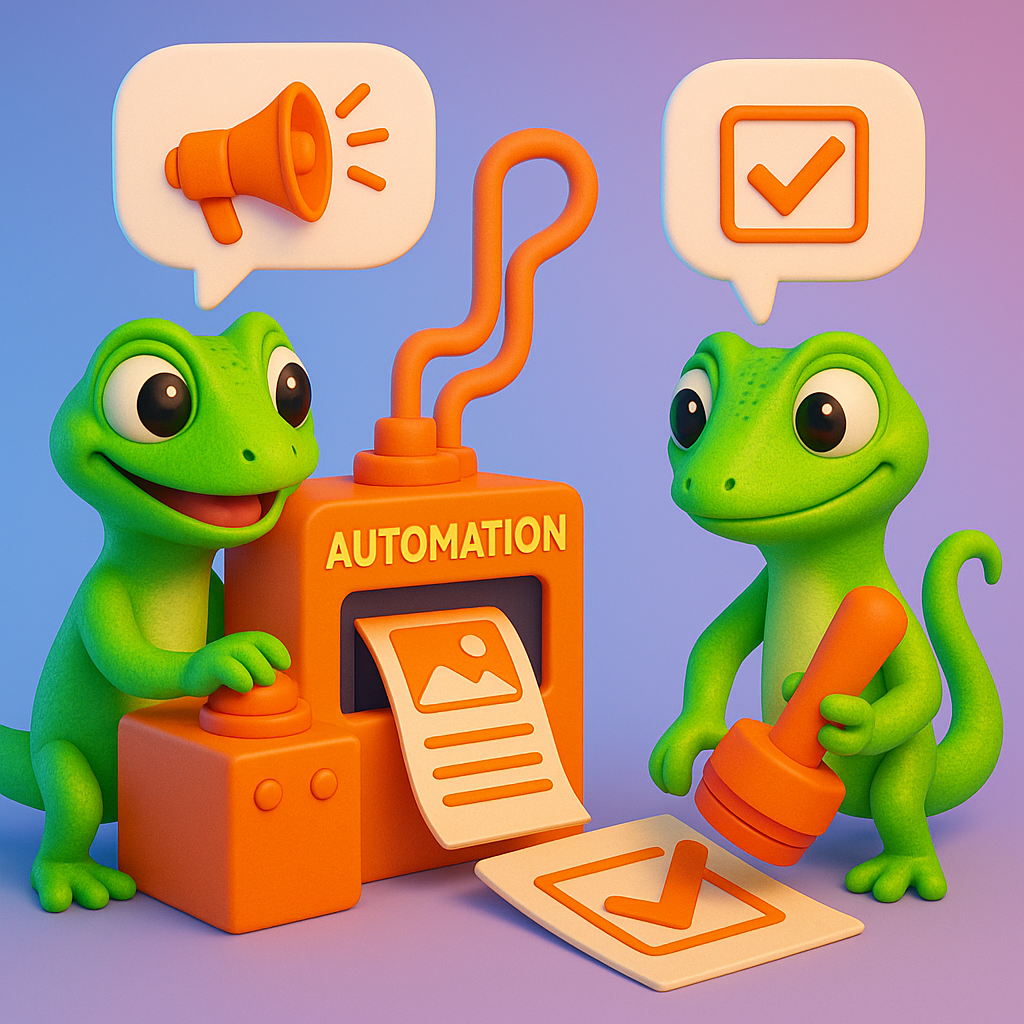Automating Content Creation for LLMo with AI-powered SEO Insights
Automated content creation using large language models is transforming how marketing teams scale their content operations. With LLMs now mediating search discovery and directly answering user queries, traditional content workflows are no longer sufficient. Organizations leveraging AI-powered automation are achieving 10X traffic growth while dramatically reducing production time and resources—earning $5.44 for every $1 spent on marketing automation according to recent industry statistics.
Understanding LLM Content Automation
LLM content automation uses AI to streamline the entire content creation process—from keyword research and topic clustering to drafting, optimization, and publication. Unlike basic AI writing tools, sophisticated LLM automation integrates SEO data and machine learning to create content specifically optimized for both traditional search engines and LLM-powered search platforms.

The shift toward LLM-mediated search is significant: Harvard Business Review reports 58% of consumers now use generative AI for recommendations (up from 25% in 2023), with LLM search projected to drive 75% of revenue by 2028 according to research on LLM search. This trend is driving the explosive growth of the LLM content creation market, which is projected to grow at a 40.6% CAGR, reaching $75.5 billion by 2034 according to market research.
Best Practices for Automated Content Creation
1. Implement Structured Prompt Engineering
Effective LLM automation requires sophisticated prompt engineering that incorporates:
- Audience intent analysis
- Keyword clustering data
- Brand voice parameters
- Content structure requirements
- Factual accuracy guidelines
Rather than generic prompts, successful organizations use structured frameworks that guide LLMs to produce content aligned with both search intent and business objectives. This approach allows for consistent output quality while maintaining brand voice, as detailed in large language model optimization research.
For example, a structured prompt for a product comparison article might include specific instructions on competitive analysis metrics, formatting requirements for feature tables, and brand-specific tone guidelines—all informed by keyword research data.
2. Establish Hybrid Human-AI Workflows
The most effective content automation doesn’t eliminate humans—it transforms their role:
LLM Automation Tasks | Human Oversight Tasks---------------------------|-------------------------Keyword research | Strategic directionTopic clustering | Brand voice alignmentFirst draft creation | Factual verificationSEO optimization | Competitive differentiationContent formatting | Final approvalIndustry benchmarks show this hybrid approach delivers the best results, with 91% of decision-makers reporting rising automation demands while still valuing human creativity and strategic input. This mirrors findings that 88% of professionals report improved work quality with LLMs according to statistics on LLM adoption.
A practical implementation might involve AI generating the initial content structure and draft based on SEO data, with human editors focusing on adding unique insights, refining the brand voice, and ensuring factual accuracy.
3. Implement Layered Content Optimization
Modern content must be optimized for multiple search environments simultaneously:
- Answer Engine Optimization (AEO): Structured for direct question answering
- Generative Engine Optimization (GEO): Formatted for AI citation and referencing
- Traditional SEO: Optimized for keyword ranking and click-through
This multi-layered approach addresses the differences between traditional SEO and LLMo techniques, ensuring content performs across all search environments.
Consider how a comprehensive guide might include direct answer snippets for voice search (AEO), properly structured citations and fact statements for AI reference (GEO), while still maintaining keyword optimization and engagement elements for traditional search rankings.
Essential Tools for Automating LLM Content Creation
Keyword Research and Clustering Tools
AI-powered keyword clustering tools dramatically enhance content planning efficiency. Free keyword clustering tools can process thousands of keywords in minutes, grouping them semantically to:
- Prevent keyword cannibalization
- Identify content gaps
- Map user journeys
- Structure comprehensive topic clusters
Case studies show this approach helped one e-commerce platform eliminate keyword cannibalization, gaining 2,172 monthly clicks and top-10 rankings across previously competing terms. This aligns with broader industry trends showing retail and e-commerce businesses as the largest LLM adopters with 27.5% market share according to precedence research.
LLM-Optimized Content Generation
Advanced content writer generators go beyond basic text creation by:
- Analyzing SERP and search intent
- Evaluating competitive content
- Researching facts via specialized AI models (Perplexity, DeepSeek R1)
- Creating structured content optimized for both human readers and AI systems
- Adding proper citations and references
These sophisticated systems enable companies to scale from 5 to 50 monthly content pieces without adding staff while maintaining quality standards. For example, Promoty achieved 224% traffic growth and 45% signup increase using AI-driven SEO and keyword clustering strategies—demonstrating the potential of well-implemented automation.
Performance Monitoring Systems
Tracking LLM-optimized content requires specialized metrics beyond traditional SEO KPIs. Advanced tools for monitoring LLMo performance track:
- AI citations and references
- Content retrieval rates
- LLM visibility scores
- AI-specific conversion paths
- Traditional SEO metrics
These monitoring capabilities allow organizations to continually refine their automation strategies based on performance data. The integration of these tools with existing analytics creates a complete picture of content performance across both traditional and AI-mediated search environments.
Measuring the ROI of Automated Content Creation
The business impact of LLM content automation is substantial, with documented results including:
- Time savings: 50–75% reduction in content production time (with HubSpot users saving approximately 12.5 hours weekly)
- Traffic growth: Up to 224% monthly traffic increase in 4 months
- Content velocity: 10x increase in content output without additional staff
- Cost efficiency: $5.44 earned for every $1 spent on marketing automation
- Quality improvements: Consistent brand voice with enhanced factual accuracy
Organizations can calculate their own potential returns using specialized SEO ROI calculators that account for both traditional metrics and emerging LLM-specific KPIs. These calculators help marketing leaders justify automation investments by projecting potential traffic growth, conversion improvements, and resource savings.
Implementation Challenges and Solutions
Brand Voice Consistency
Challenge: Maintaining distinctive brand voice across automated content.
Solution: Train LLMs on brand-specific content examples and implement stylebook enforcement via human editorial review. This creates a virtuous cycle where the system continuously improves its alignment with brand standards.
For example, one B2B software company created a “brand voice library” containing examples of their unique terminology, preferred sentence structures, and tone variations for different content types. This library became the foundation for their LLM prompt engineering, resulting in 92% accuracy in maintaining brand voice consistency.
Factual Accuracy
Challenge: Ensuring automated content remains factually accurate.
Solution: Implement tiered verification systems combining AI research tools like Perplexity with human fact-checking protocols. Establish clear citation requirements and source quality standards.
A practical approach includes using specialized research-focused LLMs for initial fact verification, followed by human subject matter expert review for critical claims or complex topics. This dual-layer approach balances efficiency with accuracy.

Team Adoption
Challenge: Overcoming resistance to AI-powered content automation.
Solution: Position automation as an amplifier of human creativity rather than a replacement. Demonstrate ROI through pilot projects focusing on high-volume, routine content needs first.
Marketing teams that successfully adopt LLM automation typically start with a phased implementation approach, beginning with the most repetitive content tasks (like product descriptions or basic FAQs) before moving to more complex content types. This builds team confidence while delivering immediate efficiency gains.
Implementing an Automated Content Strategy
- Audit current content performance to establish baselines
- Identify high-volume, routine content needs ideal for automation
- Select appropriate tools for your specific content requirements
- Develop brand-aligned prompt libraries and templates
- Establish quality control workflows combining AI and human oversight
- Implement tracking systems to measure performance
- Continuously refine based on performance data
Organizations like ContentGecko specialize in implementing these systems at scale, helping marketing teams achieve 10X organic traffic growth without the need for large content teams or agencies.
TL;DR
Automating content creation with LLMs delivers transformative results when implemented strategically. By combining AI-powered keyword clustering, sophisticated content generation, and hybrid human-AI workflows, organizations can dramatically scale content production while maintaining quality and brand standards. The most successful implementations balance technical optimization with strategic brand alignment, creating AI-powered systems that drive measurable outcomes while maintaining brand voice. With the LLM content creation market growing at 40.6% annually, organizations that master these automation techniques gain significant competitive advantages in both efficiency and effectiveness.
